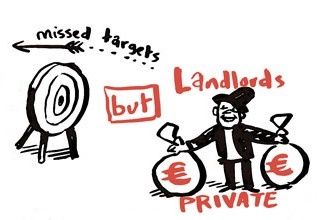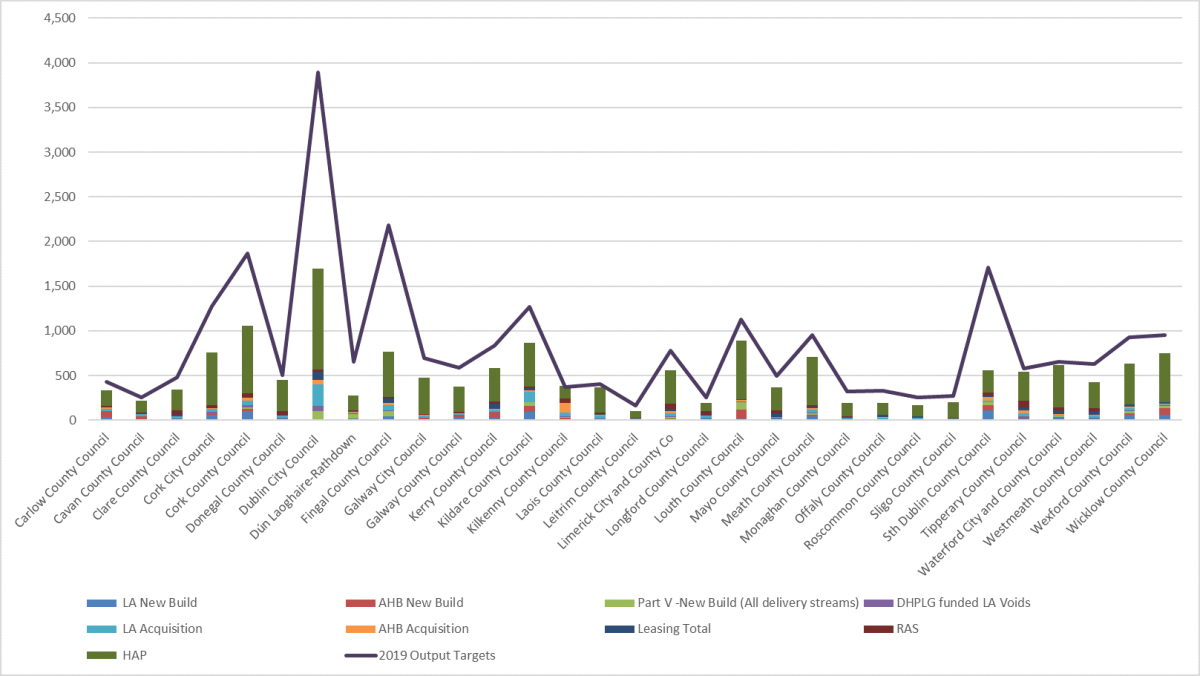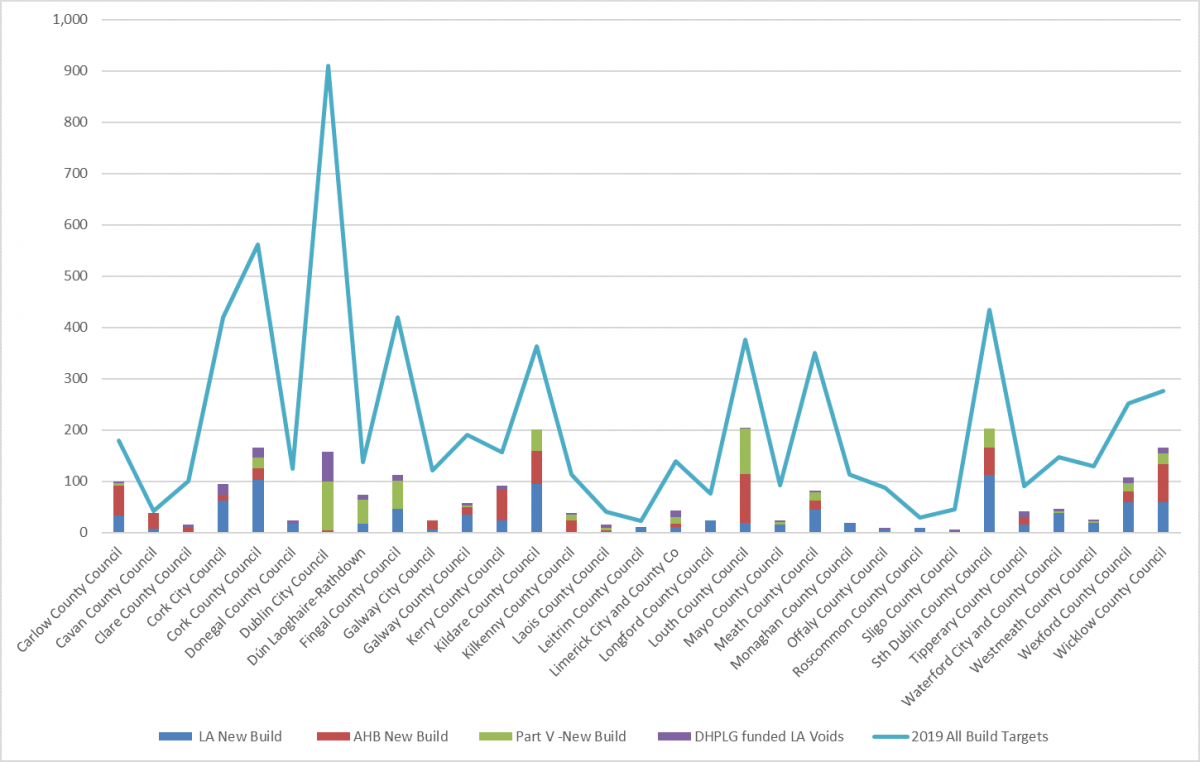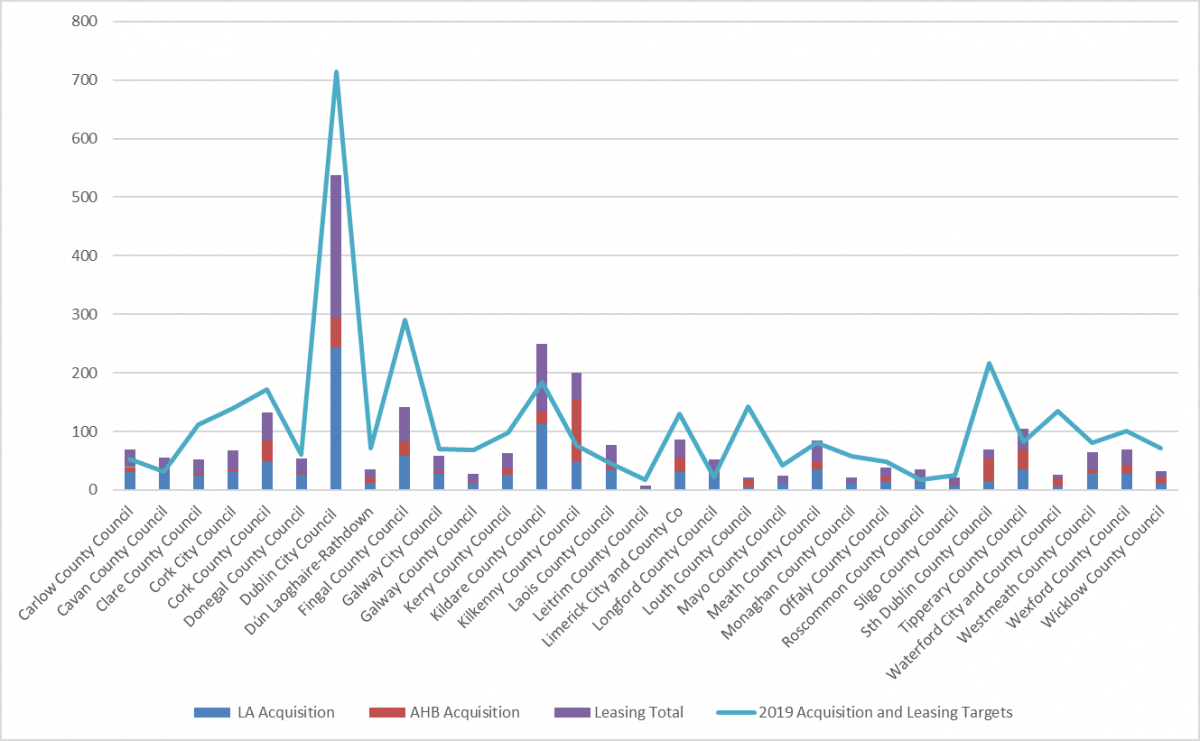Social Housing Output off target while private subsidies increase

The latest data released by the Department of Housing, Planning and Local Government, up to Q3 2019, show that Local Authorities met just 66% of their social housing output targets in the first three quarters of last year. Just one Local Authority (Kilkenny County Council) met its full output target, while South Dublin County Council and Fingal County Council met just 33% and 35% respectively.
Chart 1 shows the composition of Social Housing Output for each Local Authority area up to Q3 2019 compared to the target output for that local authority for the full year. The proportion of the 2019 target met ranges from 33% in South Dublin County Council to 102% in Kilkenny County Council, with a median of 69% and an average of 66%.
Chart 1: Social Housing Output by Type and Targets, Q3 2019

Source: Analysis of Social Housing Output Overview by LA 2019, Department of Housing, Planning and Local Government
Notes: LA New Build includes units delivered through Rapid, Traditional, Turnkey and Regeneration
AHB New Build includes CAS and CALF New Build
Part V New Build includes Part V's delivered under LA Build and AHB Build
New leasing units operational are defined as the number of new leasing units delivered under this scheme in the given period. This program was previously known as long term leasing until 2014.
RAS - New transfers is defined as the number of households which have moved from Rent Supplement to RAS in that specific year. It includes households who remained in their existing accommodation and those for whom the LA had to source new properties.
HAP - New Households Supported refers to the number of qualified households with an established housing need who are being accommodated under the HAP scheme for that year. The first phase of the statutory pilot for the HAP scheme commenced in September 2014 and the data for 2014 refers to new households supported between September and December 2014.
LA Voids includes voids beyond the void target set under Rebuilding Ireland 2018. Of the total of 1765 Voids, claims in respect of 1733 were paid in 2018 and following resolution of queries the balance were funded in early 2019.
In addition to the HAP output reflected for Dublin City Council, the Dublin Regional Homeless Executive supported some 2,287 households from the 4 Dublin Local Authorities under Homeless HAP in 2018. These are reflected within the overall HAP output for each individual LA.
The Housing Assistance Payment (HAP), a subsidy to landlords in the private rented sector, continued to outpace the provision of long-term sustainable homes, accounting for 72% of all Social Housing Output in the reporting period. According to the Local Authority Budgets 2019, estimated expenditure on HAP in 2019 was €545 million.
When the ‘build’ data and associated targets are isolated (Chart 2) we can see that no Local Authority had yet met its 2019 target. While Cavan County Council, at 93%, was within a reasonable distance of its 2019 target by the end of Q3 2019, this is unlikely to be the case for others, with Wicklow County Council having the second highest proportion of its targets met, at 60%. Local Authorities in Offaly (11%), Sligo (13%), Clare (15%), Monaghan (17%), Dublin City (17%) and Donegal (19%) were all below 20% of their target by the end of Q3 2019.
Chart 2: ‘All Builds’ by Build Type and Targets, Q3 2019

Source: Analysis of Social Housing Output Overview by LA, Department of Housing, Planning and Local Government
Notes: As per Chart 1.
As in 2018, the numbers acquired and leased, compared to the targets set in this area, faired better in terms of targets reached. As can be seen in Chart 3, targets were exceeded in 9 Local Authority areas (Kilkenny (264%), Longford (236%), Roscommon (194%), Cavan (177%), Laois (171%), Kildare (135%), Carlow (130%), Tipperary (127%) and Meath (104%)).
In terms of the actual number of units provided through this method, more social housing units were provided through Acquisitions and Leasing than actual builds (including Regeneration) in 19 of the 31 Local Authority areas, an increase from 14 of the 31 for this period in 2018.
Speed of delivery is likely a contributing factor in why Acquisitions and Leases are outperforming their targets, however in many areas this would be a more expensive form of housing provision compared to Local Authorities and Approved Housing Buildings, particularly if using State lands. The continuing cost to the Exchequer must also be a factor in determining the best method and it is time that a full comparative long-term cost analysis is developed.
Chart 3: Acquisitions and Leasing by Type and Target, Q3 2019

Source: Analysis of Social Housing Output Overview by LA, Department of Housing, Planning and Local Government
Notes: As per Chart 1.
As can be seen in Table 1, the proportion of Social Housing Output attributed to HAP can be as much as 85% (in Galway City and Sligo), with a median of 71% and those Local Authorities at the lower end of the scale still providing between a third and a half of their social housing through this method. Galway City Council, which sourced the highest proportion of its social housing output via HAP in this period in 2018, is joint highest in Q3 2019.
Table 1: Delivery Method as % of all Social Housing Output per Local Authority, Q3 2019

Source: Analysis of Social Housing Output Overview by LA, Department of Housing, Planning and Local Government
Notes: As per Chart 1
Local Authorities and Local Representatives must be accountable for their budgetary decisions in the midst of a housing crisis. This housing crisis is now also having an impact on the ability of thousands of people to protect themselves in the midst of a pandemic. Bold moves, such as large-scale investment in public housing, are required to protect all people at this time, and the vulnerable cannot be left further behind.